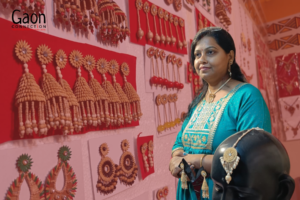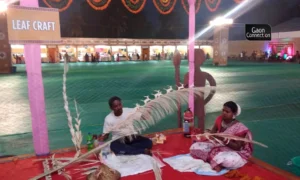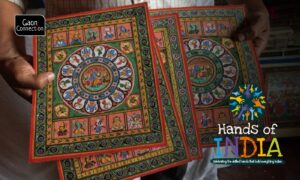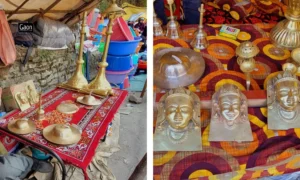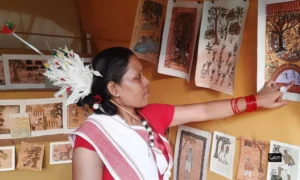At the Dastgeer Sahab in Khanyar, Safakadal, Srinagar, the faithful pray at the 200 odd-year-old Sufi shrine, with beautifully crafted Khatamband or wooden ceiling.
“It is still beautiful, but it pales in comparison to the original ceilings with its floral designs. The ceiling added to the mystic and meditative ambience of the shrine,” Saleem, the warden of the shrine, told Gaon Connection.
Sadly, the original and distinctive Khatamband ceiling burnt to a cinder in a raging inferno, in June 2012.“The new shrine was rebuilt along the lines of the original structure, but the concrete used in the modern building just does not have the same magic,” Saleem said.
The Khatamband ceiling is one of the legacies of the valley’s traditional architecture. The beautifully handcrafted ceilings, replete with motifs, made entirely of wood, was a common feature of all buildings in the region, be it palaces, shrines, mosques, homes of nobles, and even houseboats.
Also Read: Reviving the Kashmiri Craft of Namda Making
Khatamband craft of Kashmir
Khatambands are decorative ceilings fashioned out of interlocking polygonal pieces of wood into each other in geometrical patterns.
The Persian word Khatam Bandh means ‘coming full circle’. The distinctive ceiling design, it is believed, was brought to Kashmir by Mirza Hyder Tughlaq in 1541, in the Mughal era.
But there is also a theory that the scholar saint Shah Hamadani visited the valley to propagate Islam, and in his entourage were Khatamband artists. They came from Persia (present day Iran) in the 14th Century and an old shrine, Khankahi-Moula, dedicated to him still stands in Srinagar with the most complex Khatamband installation.
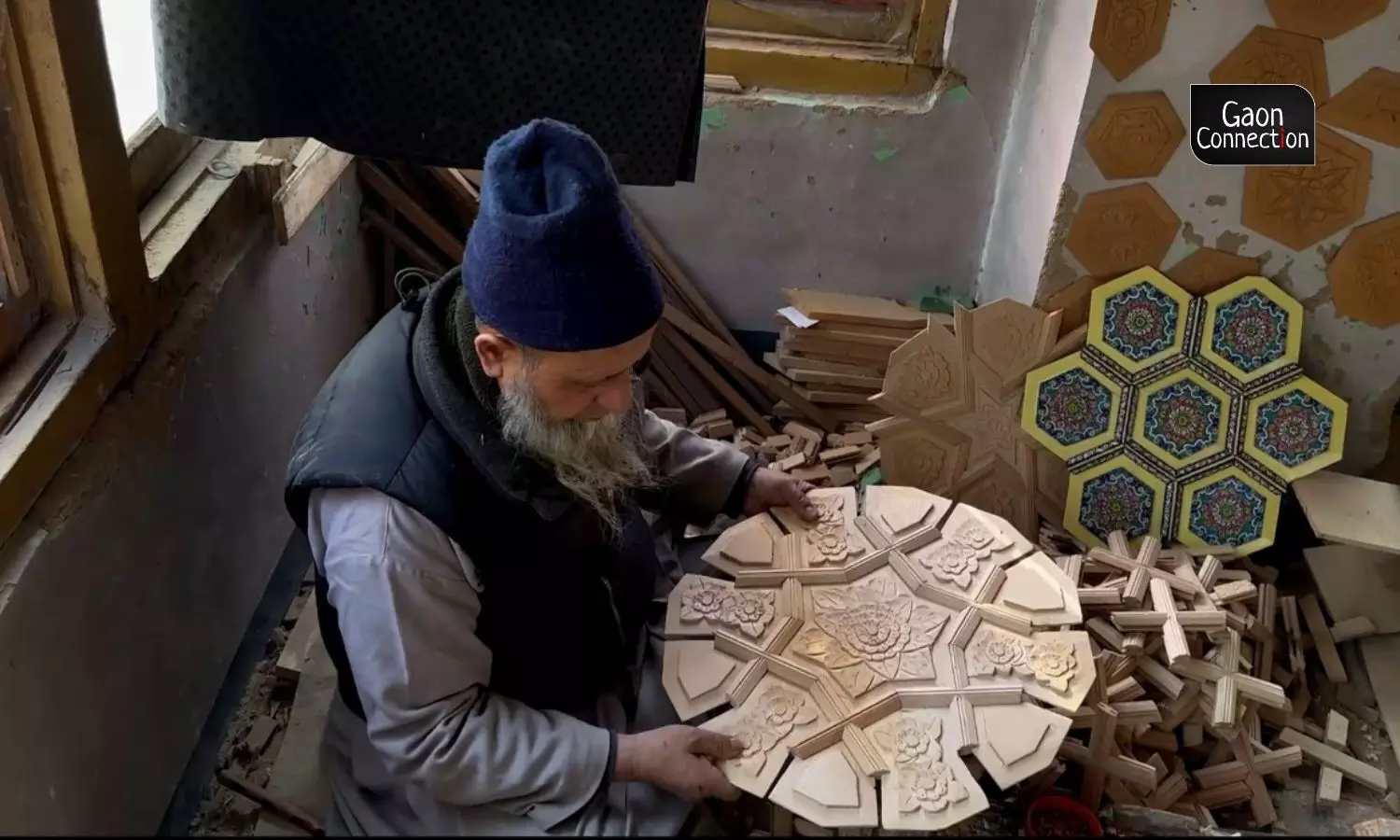
The Khatamband ceiling is one of the legacies of the valley’s traditional architecture.
In the old part of Srinagar in Safakadal is a sawdust filled workshop of Ali Mohammad Giru.
“I continue to be inspired by this craft just as my father, grandfather and his ancestors were. They were all craftspeople who created beautiful Khatamband ceilings,” Giru told Gaon Connection. “I can’t even think of doing anything else,” he added as his hands carved out a chinar leaf motif.
Giru’s karigars sit around him bent over the work of fitting together pieces of wood that will finally take shape as a Khatamband.
The Khatamband ceiling has a long life and is perfect for the climatic conditions of the valley, Giru told Gaon Connection.
“If you see the heritage structures of the old city, you will realise that the Khatamband was a way of life for our ancestors,” said the old carpenter, fondly called Wusta or master, by his colleagues and customers. “Many of those rundown structures have now become a signpost of Kashmir’s rich heritage past,” he said.

Giru’s karigars sit around him bent over the work of fitting together pieces of wood that will finally take shape as a Khatamband.
Also Read: Kashmiri carpet weavers burn the midnight oil to weave silk kaleens for the new Parliament building
Khatamband’s seamless geometric pattern makes one feel one is staring at a starry sky, Giru said as he reeled off the names of the various designs used on the ornate ceilings. Beet Dar, Mouje Lehar, Has Pohal, Dawazdha Girid, Chengis Kani, Chaar Baksh, Hastubal, Pohal Muraba and Muraba Badam are some of them.
“The ceilings are made of wood from the fir tree usually as it is light and at the same time sturdy,” he explained.
While traditionally, in the days of yore about 100-150 pieces were made in a day, entirely by hand, now, thanks to mechanisation, up to 2,500 pieces can be churned out, if there is uninterrupted electricity, Giru said. “A Khatambandi ceiling can cost anything between Rs 250 and Rs 1,000 per square feet, depending on the design,” he said.
“Khatamband has health benefits. The wooden ceiling retains the warmth during winters, and has a cooling effect in the summers,” Master Misgar, a carpenter in his mid-60s, told Gaon Connection.
Thanks to craftspeople like Misgar and Ali Mohammad, the craft of Khatambandh is still extant.
Return of the traditional ceilings
Like it has been with other arts and crafts, the Khatamband also faced a slump. “These busy buzzing workshops you see now wore a deserted look. The emergence of new housing patterns and designs had created a new market appetite, where traditional ceilings had no role to play,” Ali Mohammad, another craftsman in his 70s now, told Gaon Connection.
Fortunately, there has been a resurgence of demand for the Khatamband ceilings with more and more people returning to their roots and wanting their new homes to have a bit of the traditional past too, Ali said.
There are about 600 master carpenters who still create the works of art in the old city of Srinagar. “They can make up to 100 different designs. Most of the craftsmen come from Safakadal, Eidgah and Lal Bazar areas,” Mohammad Ali said.

There has been a resurgence of demand for the Khatamband ceilings with more and more people returning to their roots and wanting their new homes to have a bit of the traditional past too.
As Khatamband ceilings are becoming popular again, things are looking up, said Giru. “By the grace of God, I have worked in every state of India. We recently completed projects in Bengaluru and Goa. I have done work in Dubai and Nepal too,” Najar told Gaon Connection. Giru has a team of 10 artists working for him. “They are all educated people who are happy in this profession,” he said.
Gaon Connection reached out to Mehmood Ahmad Shah, director of handicrafts, to get his comments on the state of the Khatamband craft, but he did not respond.







